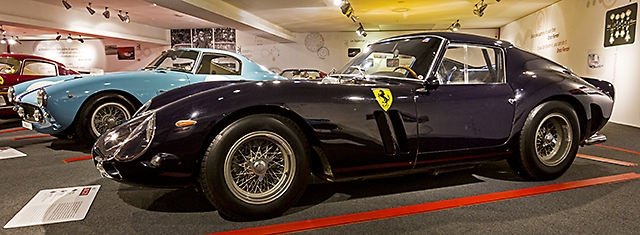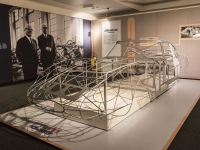Automobiles
Ferrari 250 GTO is the car that every man dreams of having
F 250 GTO is the most beautiful car

Ferrari 250 GTO (Source: Roberto Magni By Foto ReD Photographic Agency )
USPA NEWS -
The Ferrari 250 GTO is a GT car produced by Ferrari from 1962 to 1964 for homologation into the FIA's Group 3 Grand Touring Car category. It was powered by Ferrari's Tipo 168/62 V12 engine.
The "250" in its name denotes the displacement in cubic centimeters of each of its cylinders; "GTO" stands for "Gran Turismo Omologato",Italian for "Grand Touring Homologated."
Just 39 250 GTOs were manufactured between 1962 and 1964. This includes 33 cars with 1962-63 bodywork (Series I), three with 1964 (Series II) bodywork similar to the Ferrari 250 LM, and three "330 GTO" specials with a larger engine. Four of the older 1962-1963 (Series I) cars were updated in 1964 with Series II bodies.
When new, the GTO cost $18,000 in the United States, with buyers personally approved by Enzo Ferrari and his dealer for North America, Luigi Chinetti. In May 2012 the 1962 250 GTO made for Stirling Moss set an all-time record selling price of $38,115,000. In October 2013, Connecticut-based collector Paul Pappalardo sold chassis number 5111GT to an unnamed buyer for a new record of around $52 million.
The "250" in its name denotes the displacement in cubic centimeters of each of its cylinders; "GTO" stands for "Gran Turismo Omologato",Italian for "Grand Touring Homologated."
Just 39 250 GTOs were manufactured between 1962 and 1964. This includes 33 cars with 1962-63 bodywork (Series I), three with 1964 (Series II) bodywork similar to the Ferrari 250 LM, and three "330 GTO" specials with a larger engine. Four of the older 1962-1963 (Series I) cars were updated in 1964 with Series II bodies.
When new, the GTO cost $18,000 in the United States, with buyers personally approved by Enzo Ferrari and his dealer for North America, Luigi Chinetti. In May 2012 the 1962 250 GTO made for Stirling Moss set an all-time record selling price of $38,115,000. In October 2013, Connecticut-based collector Paul Pappalardo sold chassis number 5111GT to an unnamed buyer for a new record of around $52 million.
In 2004, Sports Car International placed the 250 GTO eighth on a list of Top Sports Cars of the 1960s, and nominated it the top sports car of all time. Similarly, Motor Trend Classic placed the 250 GTO first on a list of the "Greatest Ferraris of All Time." Popular Mechanics named it the "Hottest Car of All Time."
Tipo 168/62 V12 engine
The 250 GTO was designed to compete in GT racing, where its rivals would include the Shelby Cobra, Jaguar E-Type and Aston Martin DP214. The development of the 250 GTO was headed by chief engineer Giotto Bizzarrini. Although Bizzarrini is usually credited as the designer of the 250 GTO, he and most other Ferrari engineers were fired in 1962 due to a dispute with Enzo Ferrari. Further development of the 250 GTO was overseen by new engineer Mauro Forghieri, who worked with Scaglietti to continue development of the body. The design of the car was a collaborative effort and cannot be ascribed to a single person.
The mechanical aspects of 250 GTO were relatively conservative at the time of its introduction, using engine and chassis components that were proven in earlier competition cars. The chassis of the car was based on that of the 250 GT SWB, with minor differences in frame structure and geometry to reduce weight, stiffen and lower the chassis. The car was built around a hand-welded oval tube frame, incorporating A-arm front suspension, rear live-axle with Watt's linkage, disc brakes, and Borrani wire wheels. The engine was the race-proven Tipo 168/62 Comp. 3.0 L V12 as used in the 250 Testa Rossa Le Mans winner.
An all-alloy design utilizing a dry sump and six 38DCN Weber carburetors, it produced approximately 300 horsepower. The gearbox was a new 5-speed unit with Porsche-type synchromesh.
Bizzarrini focused his design effort on the car's aerodynamics in an attempt to improve top speed and stability. The body design was informed by wind tunnel testing at Pisa University as well as road and track testing with several prototypes. The resulting all-aluminium bodywork had a long, low nose, small radiator inlet, and distinctive air intakes on the nose with removable covers. Early testing resulted in the addition of a rear spoiler. The underside of the car was covered by a belly pan and had an additional spoiler underneath formed by the fuel tank cover. The aerodynamic design of the 250 GTO was a major technical innovation compared to previous Ferrari GT cars, and in line with contemporary developments by manufacturers such as Lotus. The bodies were constructed by Scaglietti, with the exception of early prototypes with bodies constructed in-house by Ferrari or by Pininfarina (in the case of s/n 2643 GT). Cars were produced in many colours, with the most famous being the bright red "Rosso Cina".
The minimalist interior of a 250 GTO reflects the car's racing intentions. There is no speedometer, seats are cloth-upholstered, and neither carpeting nor a headliner was installed. Cockpit ventilation is via exterior air inlets. The exposed metal gate defining the shift pattern became a Ferrari tradition maintained in production models until replaced by steering column-mounted paddle shifters in the 2000s.
Model with its air intake covers removed
Handbuild production, updates, and repairs throughout each car's competition history result in differences both visible and invisible between individual 250 GTOs. Variance in air intake/vent configuration is common among cars. Modifications to the original bodywork were performed by the factory, Scaglietti, or other body shops, usually after crashes or according to a racing team's wishes.
In 1964, Ferrari tasked Mauro Forghieri and Mike Parkes with redesigning the 250 GTO's bodywork. Minor modifications to the engine, gearbox, chassis, and interior were incorporated into a design called the GTO '64 (or Series II) was visually similar to the 250 LM, though without its mid-engined layout. Three cars were produced to this specification, and four earlier 250 GTOs were retrofitted to it by the factory.
Three 330 GTO specials were made using the 250 GTO chassis and body fitted with 400 Superamerica 4.0L motors. Distinguished by a larger bonnet bulge, these cars were used briefly for racing and testing by Scuderia Ferrari before being sold to private customers.
The 330 LMB is sometimes considered a GTO variant. These cars used a 4.0L 330 motor and a modified 250 GT Lusso chassis/body. Four were produced in 1963.
more information: https://www.fotoredagency.com
Liability for this article lies with the author, who also holds the copyright. Editorial content from USPA may be quoted on other websites as long as the quote comprises no more than 5% of the entire text, is marked as such and the source is named (via hyperlink).








